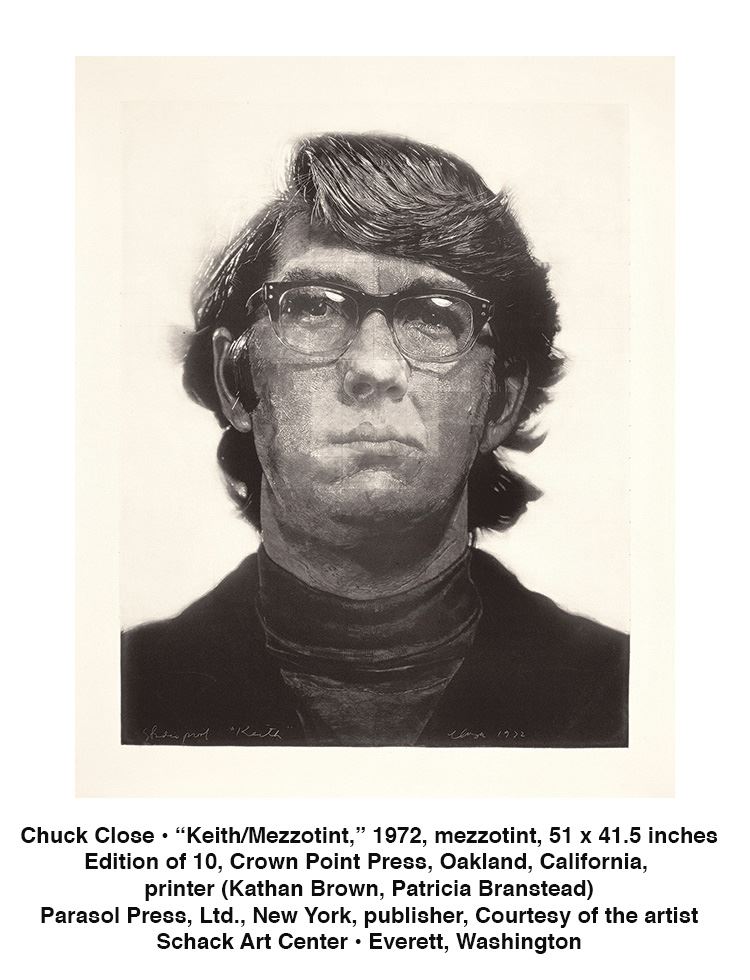 Nothing is as it seems in “Chuck Close Prints: Process and Collaboration” at the Schack Art Center in Everett. First, although Close has spent his entire career creating art based on close up frontal portraits, the exhibition is not about portraiture. Second, the subjects of these portraits, his friends, matter little: we see the same faces over and over frozen in time. Third, super-realism, Close’s 1980s “label” as a contemporary artist, also sends us in the wrong direction.
Nothing is as it seems in “Chuck Close Prints: Process and Collaboration” at the Schack Art Center in Everett. First, although Close has spent his entire career creating art based on close up frontal portraits, the exhibition is not about portraiture. Second, the subjects of these portraits, his friends, matter little: we see the same faces over and over frozen in time. Third, super-realism, Close’s 1980s “label” as a contemporary artist, also sends us in the wrong direction.
To understand and enjoy this show, start with the odd looking “jigsaw woodblock” hanging on the wall near the entrance. Each large piece is a different color. It provides an immediately understandable example of the imaginative approach to traditional techniques and processes — that is the real subject of the show. The jigsaw woodblock, together with other techniques, leads to a dizzying centrifugal woodcut portrait of the artist Lucas Samaras, a proof with fauve colors almost obliterating the face. Although Close begins with a photograph, he departs from photorealism in every imaginable direction. In the case of the jigsaw woodblock, he challenged master printmaker, Karl Hecksher, to create a print from a multicolored painting. Frequently the experiments in printmaking, as in the case of the jigsaw woodblock, come from master printmakers endeavoring to realize Close’s intense and original concepts. Thus the term “collaboration” in the title of the exhibition.

“Keith/Mezzotint,” 1972, Close’s first print, presents a seventies guy (big eyeglasses, hair sweeping over forehead), but the fragments of the portrait nearby reveal the intricacy of each detail of the face. When Close created this large print in the early 1970s, the old master medium of mezzotint was out of fashion. Even as an emerging young artist, Close always decided to take a challenging path, turning away from his facility as a painter, a colorist, and an abstract expressionist. In the late 1980s, when he was struck with paralysis, that state of mind saved his career and enabled him to continue to work in ever more complex experiments in media and process.
Chuck Close was born and grew up in Everett, Washington, but this exhibition marks the first time his works have been shown there. Created in 2003 in collaboration with curator Terrie Sultan, “Chuck Close Prints: Process and Collaboration,” has traveled the world. The Schack Art Center version spans from 1972–2014.
 Included in the exhibition are almost 90 wood cuts, silkscreens, lithographs, paintings, tapestries as well as test charts, pulp paper samples, linoleum, and a brass “shim” to create one of my favorite prints, “Georgia,” 1984. Made of air dried handmade paper, its texture suggests an offbeat experiment, inspired, according to the curator, by an accident of chunks of pulp paper falling on the floor. Each segment of the metal shim is labeled with a number referring to the many toned gray scale in the print.
Included in the exhibition are almost 90 wood cuts, silkscreens, lithographs, paintings, tapestries as well as test charts, pulp paper samples, linoleum, and a brass “shim” to create one of my favorite prints, “Georgia,” 1984. Made of air dried handmade paper, its texture suggests an offbeat experiment, inspired, according to the curator, by an accident of chunks of pulp paper falling on the floor. Each segment of the metal shim is labeled with a number referring to the many toned gray scale in the print.
Every accident is an opportunity for Close.
The exhibition distinguishes European oil-based printmaking, used for “Lucas” and “ukiyo-e” water based prints. (I have always thought that the term ukiyo-e referred only to the subject of pleasure women in Japan). Yasu Shinbata took three years to create 120 color woodblocks for the print based on the oil portrait of “Emma” from 2002. You can see a few of the woodblocks in the exhibition.
The tapestries also amaze. Called Jacquard tapestries, they combine the automated loom, created in the late 18th century by Joseph-Marie Jacquard, with contemporary data and electronics to create stunningly subtle tapestries in gray scales as well as a five hundred color self portrait of the artist.
One of the joys of the exhibition is that it demands that we slow down and immerse ourselves in order to grasp its complexities. Simply looking closely at a single print, such as “Alex, Reduction Block,” 1993, which has a long backstory about the process, I found myself mesmerized by the fine details. In a way, they are a return to the abstraction that Close rejected so early in his career. 
Be sure to go to the back of the last wall upstairs to see the woodburytype prints, a luscious black and white process that predates photography.
Dive in and take your time. Explore. Chuck Close never stops exploring, and here is your opportunity to join him in that adventure.
Susan Noyes Platt, Ph.D.
Susan Noyes Platt, Ph.D. is an art historian, art critic, curator, and activist. She continues to address politically engaged art on her blog www.artandpoliticsnow.com.
“Chuck Close Prints: Process and Collaboration” is on view through September 5, Monday through Friday from 10 A.M. to 6 P.M. Saturday from 10 A.M. to 5 P.M., and Sunday from noon to 5 P.M. at the Schack Art Center, located at 2921 Hoyt Avenue in Everett, Washington. For more information, visit www.schack.org.